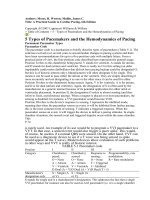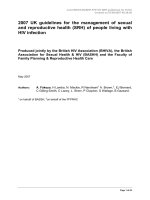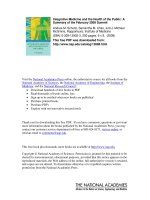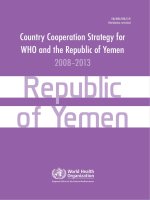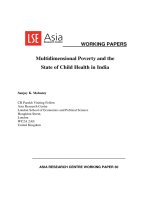Cholelithiasis and the risk of intrahepatic cholangiocarcinoma: A meta-analysis of observational studies
Bạn đang xem bản rút gọn của tài liệu. Xem và tải ngay bản đầy đủ của tài liệu tại đây (566.84 KB, 7 trang )
Cai et al. BMC Cancer (2015) 15:831
DOI 10.1186/s12885-015-1870-0
RESEARCH ARTICLE
Open Access
Cholelithiasis and the risk of intrahepatic
cholangiocarcinoma: a meta-analysis of
observational studies
Hao Cai1, Wen-Tao Kong2, Chao-Bo Chen3, Guo-Ming Shi1, Cheng Huang1, Ying-Hao Shen1 and Hui-Chuan Sun1*
Abstract
Background: The etiological factor for intrahepatic cholangiocarcinoma (ICC) is not clear. Although it has been
widely accepted that intrahepatic biliary tree stone is associated with increased risk of ICC, the role of extrahepatic
biliary tree stone in the incidence of ICC is controversial. In the present study we aim to evaluate the association
between pre-existing choledocholithiasis and cholecystolithiasis and the risk of ICC.
Methods: PubMed, Embase, and Web of Science were searched to identify cohort and case–control studies
on the association between choledocholithiasis or cholecystolithiasis and the risk of ICC. Studies that met the
inclusion criteria were subjected to a meta-analysis performed with Stata statistical software. Either a fixed
or random effect model was used, depending on the heterogeneity within the studies. Egger’s test was
performed to assess publication bias.
Results: Seven case–control studies met our inclusion criteria. Of the 123,771 participants, 4763 (3.85 %) were patients
with ICC, and 119,008 were tumor-free controls. The presence of pre-existing bile duct stones (choledocholithiasis
alone or choledocholithiasis accompanied by hepatolithiasis) was associated with the risk of ICC (odds ratio [OR]
17.64, 95 % confidence interval [CI] 11.14–27.95). Even the presence of choledocholithiasis alone (in the absence
of hepatolithiasis) was associated with a high risk of ICC (OR 11.79, 95 % CI 4.17–33.35). Cholecystolithiasis may possibly
contributed to the incidence of ICC (OR 2.00, 95 % CI 1.16–3.42), with large heterogeneity within studies (I2 = 78.5 %).
Conclusions: Bile duct stones including choledocholithiasis are important risk factors for ICC. Careful surveillance of
patients with extrahepatic biliary tree stone should be considered.
Keywords: Intrahepatic cholangiocarcinoma, Cholelithiasis, Choledocholithiasis, Cholecystolithiasis, Risk factors, Metaanalysis
Background
Biliary tract neoplasms are classified as intrahepatic
cholangiocarcinoma (ICC), perihilar cholangiocarcinoma, or extrahepatic cholangiocarcinoma depending
on the tumor location within the biliary tree [1]. ICC,
which is defined as being located proximally to the
second-order bile ducts, accounts for 10 % of total biliary tract neoplasms [2]. ICC, the second most frequent
liver neoplasm following hepatocellular carcinoma, is highly
malignant and shows extremely poor prognosis [3]. The
* Correspondence:
1
Liver Cancer Institute and Zhongshan Hospital, Fudan University, Shanghai
200032, China
Full list of author information is available at the end of the article
incidence of ICC is relatively low but increasing worldwide
[4, 5]. The risk factors for ICC are complex. Hepatolithiasis
(which, along with cholecystolithiasis and choledocholithiasis, is a common lithiasis arising from certain part of the
biliary tree) is an established risk factor for ICC, probably
via repeated mechanical injury and inflammation of the
intrahepatic biliary tract epithelium [4]. However, few studies have investigated the correlation between ICC and preexisting extrahepatic biliary tract stones (choledocholithiasis
or cholecystolithiasis). There is no consensus on whether
choledocholithiasis or cholecystolithiasis contribute to the
development of ICC. In the present study, we systematically
reviewed the literature on the correlation between ICC and
pre-existing cholelithiasis and performed a meta-analysis of
© 2015 Cai et al. Open Access This article is distributed under the terms of the Creative Commons Attribution 4.0
International License ( which permits unrestricted use, distribution, and
reproduction in any medium, provided you give appropriate credit to the original author(s) and the source, provide a link to
the Creative Commons license, and indicate if changes were made. The Creative Commons Public Domain Dedication waiver
( applies to the data made available in this article, unless otherwise stated.
Cai et al. BMC Cancer (2015) 15:831
relevant cohort and case–control studies to assess the risk
of ICC in patients with pre-existing choledocholithiasis and
cholecystolithiasis.
Methods
Selection of studies
PubMed, Embase, and Web of Science were searched using
the following key words: ‘Cholelithiasis’ or ‘Choledocholithiasis’ or ‘Cholecystolithiasis’; ‘Intrahepatic cholangiocarcinoma’ or ‘cholangiocarcinoma’ or ‘bile duct neoplasms’; and
‘Risk factors’ through December 2014. No limitations were
set for the language or the year of publication. The reference lists of the retrieved articles were manually searched
so that no possibly useful information was missed.
Fig. 1 Flow diagram of study selection process
Page 2 of 7
The inclusion criteria were as follows: (1) cohort or
case–control studies of the correlation between ICC and
pre-existing choledocholithiasis (with or without concurrent hepatolithiasis), or cholecystolithiasis independently; (2) studies in which the primary outcome was the
occurrence of ICC; (3) studies in which the exposure of
interest was the presence of either pre-existing choledocholithiasis (with or without concurrent hepatolithiasis)
or cholecystolithiasis; and (4) studies in which estimates
of relative risk (rate ratios, odds ratios [ORs], or standardized incidence ratios) with their 95 % confidence
intervals (CIs) were available. Studies that enrolled patients with concurrent bile duct stones and cholecystolithiasis were excluded. The flow chart for selection of
the studies is shown in Fig. 1.
Cai et al. BMC Cancer (2015) 15:831
Data extraction
Two reviewers (WK and CC, both experts in the diagnosis and treatment of hepatobiliary diseases) independently extracted the data from the selected studies using a
specially designed form. The following information was
required for our study: name of first author, publication
year, country or region, study design, number of cases
(incidence of ICC in cohort studies), number of controls
or cohort size, matched factors and confounders of each
study. The validated Newcastle–Ottawa scale was used
to assess the methodological quality of case–control and
cohort studies [6]. Any discrepancy between the 2 reviewers in selecting publications and extracting data was
resolved by discussion until a consensus was reached.
When data on both bile duct stones (choledocholithiasis
accompanied by hepatolithiasis) and choledocholithiasis
alone were provided, only the data on choledocholithiasis were recorded.
Statistical analysis
Meta-analysis was performed with Stata statistical
software (ver. 12.0, Stata, College Station, TX, USA).
Dichotomous variables were expressed as relative frequencies and were compared by means of the χ2 test.
The Cohen’s Kappa was used to assess the inter-rater
reliability for inclusion decision. Relative risks (ORs,
risk ratios, and standard incidence rates) with their
corresponding 95 % CIs were used to assess the association between the risk of the development of ICC and
pre-existing biliary stone disease. χ2 and I2 tests were used
to assess between-study heterogeneity; I2 values ≥ 25, 50
and 75 % were considered to indicate mild, moderate and
high heterogeneity. Either a fixed or random effect model
(Inverse Variance method) was used, depending on the
between-study heterogeneity. Subgroup analysis was
performed to identify confounding factors that could
possibly contribute to between-study heterogeneity.
Publication bias and other biases were assessed by
means of Egger’s test. Trim and fill tests combined with
conversion between different effect models were performed in sensitivity analysis. P ≤ 0.05 was considered
to indicate statistical significance.
Results
Selection of studies
As shown in Fig. 1, the initial database search returned
251 studies. Among these, 7 case–control studies met our
inclusion criteria and were included in our meta-analysis:
3 nationwide case–control studies and 4 hospital-based
case–control studies from 3 cities in mainland China and
1 city in Turkey (see Additional file 1: Table S1); [7–13].
The methodological quality of 3 of the studies was rated
as high (score ≥ 7); [8, 10, 12], and that of the 4 other studies was rated as moderate (4 ≤ score < 7); [7, 9, 11, 13]. A
Page 3 of 7
total of 123,771 participants were enrolled, including 4763
ICC patients and 119,008 tumor-free controls. There was
a strong consistency between the 2 reviewer in study selection (Kappa = 0.86).
Nordenstedt et al. conducted a cohort study on the association between cholecystolithiasis and the risk of ICC
in a Swedish population. However, patients who had
both cholecystolithiasis and bile duct stones were not
eliminated, so this study was excluded from our analysis
[14]. Wu et al. reported a correlation between cholelithiasis and the risk of ICC, but their study was also excluded from our meta-analysis owing to the lack of
detailed information on choledocholithiasis or cholecystolithiasis alone [15]. Welzel et al. (2007a) and Shaib et
al. conducted similar case–control studies of cholelithiasis and the risk of ICC in the United States on the basis
of the Surveillance, Epidemiology, and End Results database [7, 16]. However, the study of Welzel et al. [7] was
published more recently, so the study of Shaib et al. was
excluded.
Data synthesis
Bile duct stone and the risk of ICC
As shown in Fig. 2, 6 studies reported on the risk of ICC
in patients with bile duct stones (choledocholithiasis
with or without hepatolithiasis), with a pooled OR of
17.64 (95 % CI 11.14–27.95). There was no incidence of
ICC in patients with pre-existing choledocholithiasis in
the study of Ibrahim et al., which was therefore excluded
[13]. A subgroup analysis including the 4 studies that reported on choledocholithiasis alone and the risk of ICC
showed a pooled OR of 11.79 (95 % CI 4.17–33.35).
There was mild heterogeneity within studies (I2 = 49.8 %,
p = 0.077), and a random effect model was used. Subgroup analysis based on different regions, study designs
and NOS scores, which are possible confounding factors
was performed and shown in Table 1. The risk of ICC in
patients with bile duct stones (choledocholithiasis with
or without hepatolithiasis) remained statistically significant by different regions, study designs or NOS scores.
Cholecystolithiasis and the risk of ICC
As shown in Fig. 3, 6 of the 7 studies reported information
on cholecystolithiasis alone and the risk of ICC [8–13],
with a pooled OR of 2.00 (95 % CI 1.16–3.42); the
study of Welzel et al. [7] in a United States population did not provide detailed information on cholecystolithiasis separately, so this study was excluded from
this meta-analysis. There was high heterogeneity within
studies (I2 = 78.5 %, p = 0.000). Subgroup analysis based
on different regions, study designs and NOS scores was
performed and shown in Table 1. The outcome on the risk
of ICC in patients with cholecystolithiasis was substantially altered and no statistically significant difference was
Cai et al. BMC Cancer (2015) 15:831
Page 4 of 7
Fig. 2 Forrest plot showing the correlation between bile duct stones and the risk of intrahepatic cholangiocarcinoma. Subgroup 1 included
patients with only choledocholithiasis, whereas subgroup 2 included patients with both hepatolithiasis and choledocholithiasis
Table 1 Subgroup analysis according to region, study design
and NOS score
Heterogeneity
Confounding factors NO. studies Odds ratio (95 % CI) I2
p
Region
Eastern
BDST
4
12.34 (4.54–33.57)
59.1 % 0.062
GBST
4
1.77 (0.88–3.58)
85.7 % 0.000
BDST
2
23.35 (17.63–30.92)
0.0 %
GBST
2
2.81 (1.03–7.72)
36.3 % 0.210
Western
0.974
observed with meta-analysis of studies from eastern
countries, hospital-based studies and studies of lower
NOS scores.
Publication bias and sensitivity analysis
Egger’s test showed no evidence of publication bias for the
meta-analysis of bile duct stones (t = −2.37, p = 0.077).
However, biases existed in the meta-analysis of cholecystolithiasis (t = 2.81, p = 0.048), which could be due to high
heterogeneity within studies. A sensitivity analysis was
performed. Trim and fill analysis showed that the outcomes were not changed without trimming performed,
and the outcomes still showed statistical significance when
a fixed effect model was used.
Study design
Nationwide
BDST
3
21.07 (16.85–26.36)
0.0 %
0.494
GBST
2
2.78 (2.37–3.26)
0.0 %
0.328
BDST
3
9.75 (1.73–54.84)
62.5 % 0.056
GBST
4
1.42 (0.63–3.19)
70 %
0.019
BDST
3
18.49 (12.90–26.50)
0.0 %
0.463
GBST
3
2.58 (1.59–4.21)
53.2 % 0.118
BDST
3
9.53 (2.55–35.59)
75.2 % 0.018
GBST
3
1.57 (0.54–4.61)
79.4 % 0.008
Hospital-based
NOS score
High
Moderate
CI confidence interval, EHST extrahepatic bile duct stone or
choledocholithiasis, GBST gallbladder stone or cholecystolithiasis
Discussion
Various established risk factors are associated with the
development of ICC, including biliary parasitic infection, hepatolithiasis, bile duct cysts, primary sclerosing
cholangitis, and exposure to certain toxins [4, 17]. In
East Asian countries, hepatolithiasis and biliary parasitic infection are more common risk factors, whereas
in Western countries, primary sclerosing cholangitis is
the main risk factor for ICC [4]. Several systematic reviews and meta-analyses have suggested that there are
correlations between ICC and pre-existing diabetes,
obesity, and hepatic virus infections [18–21].
In the present study, we found that both choledocholithiasis and cholecystolithiasis were risk factors for the
development of ICC, with the risk being higher for choledocholithiasis (OR 11.79, 95 % CI 4.17–33.35). There
is a strong correlation between hepatolithiasis and ICC
Cai et al. BMC Cancer (2015) 15:831
Page 5 of 7
Fig. 3 Forrest plot showing the correlation between cholecystolithiasis and the risk of intrahepatic cholangiocarcinoma
as confirmed by literature, which is in accordance with
our findings [4]. Subgroup analysis showed that the ICC
risk was lower for choledocholithiasis alone than for
choledocholithiasis accompanied by hepatolithiasis. Even
so, choledocholithiasis alone was still associated with a
high risk of developing ICC. The mechanism by which
choledocholithiasis might lead to the development of
ICC remains unclear; cholestasis, changes in bile composition, and relevant metabolic syndromes may be involved. In addition, choledocholithiasis that drops down
from the upstream intrahepatic biliary tract may result
in chronic inflammation of the intrahepatic bile duct
epithelium. The relationship between cholecystolithiasis
and the risk of ICC is controversial; some studies show
no correlation between ICC and pre-existing cholecystolithiasis [9, 10]. Our meta-analysis showed that cholecystolithiasis was associated with the risk of developing
ICC, with significant between-study heterogeneity, which
should be interpreted with caution. Choledocholithiasis is
usually accompanied by various metabolic diseases such
as diabetes and hyperlipidemia, which have been shown to
be correlated with the development of ICC [18, 21–25].
Statistically significant heterogeneity existed within the
studies included in the meta-analysis for cholecystolithiasis, which may be attributable to differences in regions
(eastern versus western countries), study designs (nationwide versus hospital-based study), and Newcastle–Ottawa
scale scores (high versus moderate quality), as shown in
Table 1. Nationwide studies, studies of high quality or
studies enrolling participants from western countries are
more likely to produce stable outcomes with low heterogeneities. The outcome on the risk of ICC with preexisting bile duct stones was not substantially altered,
while it should be interpreted with caution for the
correlation between ICC and pre-exsiting cholecystolithiasis. Smaller sample sizes in hospital-based studies may result in larger selection bias of cases and controls. Different
study designs may lead to different Newcastle–Ottawa
scale scores or affect the methodological quality of studies,
which may account for biases in the confirmation of exposures and comparability between cases and controls. Besides, the role of cholelithiasis in the development of ICC
may be diverse in different regions. In all but one of the
included studies [7], age and sex were matched between
cases and controls. It has been reported that old men may
have a higher risk of developing ICC [4]. When we omitted the study of Welzel et al. [7] from the meta-analysis
for choledocholithiasis, the outcome still remained statistically significant. Egger’s test showed no obvious publication bias, and sensitivity analysis showed that the outcome
of the meta-analysis was stable.
Our meta-analysis does have some limitations. First,
the evidence levels of the included case–control studies
were relatively low, and there were no qualified cohort
studies. Cholelithiasis is usually accompanied by other
metabolic syndromes, which are also risk factors for the
development of ICC [22–25]. To rule out the effects of
these other factors, meta-analyses of qualified cohort
studies will be essential. Second, the number of included studies was small. Our meta-analysis included
patients from mainland China, Taiwan, the United
States, Denmark and Turkey. Evidence has shown that
the incidence of ICC varies geographically, with the
highest incidence rate being in Thailand, which may be
due to the high incidence of parasitic infections and
hepatolithiasis there [26, 27]. In addition, the prevalence of hepatitis infection, which is also a risk factor
for ICC, is higher in East Asian countries than in
Cai et al. BMC Cancer (2015) 15:831
Western countries, which is consistent with the higher
prevalence of ICC in East Asian countries [4, 19–21].
Also, the difference may be related to the genetic backgrounds of different races [28, 29]. In the future, a
greater number of qualified studies from different regions and different ethic groups are needed to draw a
more conclusive result. In addition, different pathological types of ICCs may go through different pathogenesis [30]. Also, the correlation between ICC and the
duration, size, and number of stones needs further
interpretation [31, 32].
As far as we know, this is the first systematic review
and meta-analysis of studies evaluating the association
between the risk of developing ICC and pre-existing
choledocholithiasis and cholecystolithiasis, and our
study may be of value for clinical practice. The prognosis
of ICC is extremely poor, so early diagnosis and timely
treatment of this highly malignant disease are important.
Our evidence-based study showed that patients with a
history of cholelithiasis, especially choledocholithiasis,
are at high risk of developing ICC. Therefore, routine
follow-up for these patients is critical for the early diagnosis of ICC. Early diagnosis and timely treatment can
be expected to lead to better outcomes for ICC patients.
Conclusions
Bile duct stones were found to be important risk factors
for the development of ICC. Even in the absence of
hepatolithiasis, choledocholithiasis was associated with a
high risk of ICC.
Additional file
Additional file 1: Title of dataset: Data extracted from the
studies included in the meta-analysis. NOS Newcastle-Ottawa scale,
CI confidence interval, CC case–control study, EHST extrahepatic bile duct
stone or choledocholithiasis, GBST gallbladder stone or cholecystolithiasis,
BDST bile duct stone, CLD chronic liver diseases, DM diabetes mellitus,
ALD alcoholic liver disease, IBD inflammatory bowel disease, HBV hepatitis
B virus. (DOC 62 kb)
Competing interests
The authors declared no competing interest.
Authors’ contributions
WK, CC: literature search and data extraction; WK, CC: quality assessment; HC:
statistical analysis; HC, HS: Study design; HC, HS, GS, CH, YS: manuscript writing.
All authors read and approved the final manuscript.
Acknowledgement
All persons who have made substantial contributions to this study are
listed as authors, since everyone met the criteria for authorship. There is
no funding sources for this study.
Author details
1
Liver Cancer Institute and Zhongshan Hospital, Fudan University, Shanghai
200032, China. 2Department of Ultrasound, Zhongshan Hospital Fudan
University, Shanghai 200032, China. 3Department of General Surgery, Wuxi
Xishan People’s Hospital, Wuxi, Jiangsu Province 214011, China.
Page 6 of 7
Received: 12 December 2014 Accepted: 27 October 2015
References
1. Razumilava N, Gores GJ. Cholangiocarcinoma. Lancet. 2014;383:2168–79.
2. DeOliveira ML, Cunningham SC, Cameron JL, Kamangar F, Winter JM,
Lillemoe KD, et al. Cholangiocarcinoma: thirty-one-year experience with
564 patients at a single institution. Ann Surg. 2007;245:755–62.
3. McLean L, Patel T. Racial and ethnic variations in the epidemiology of
intrahepatic cholangiocarcinoma in the United States. Liver Int. 2006;26:1047–53.
4. Tyson GL, El-Serag HB. Risk factors for cholangiocarcinoma. Hepatology.
2011;54:173–84.
5. Bridgewater J, Galle PR, Khan SA, Llovet JM, Park JW, Patel T, et al. Guidelines
for the diagnosis and management of intrahepatic cholangiocarcinoma.
J Hepatol. 2014;60:1268–89.
6. The Newcastle-Ottawa Scale (NOS) for assessing the quality of nonrandomised
studies in meta-analyses. [ />oxford.asp]
7. Welzel TM, Graubard BI, El-Serag HB, Shaib YH, Hsing AW, Davila JA, et al.
Risk factors for intrahepatic and extrahepatic cholangiocarcinoma in the
United States: a population-based case–control study. Clin Gastroenterol
Hepatol. 2007;5:1221–8.
8. Welzel TM, Mellemkjaer L, Gloria G, Sakoda LC, Hsing AW, El Ghormli L, et al.
Risk factors for intrahepatic cholangiocarcinoma in a low-risk population:
a nationwide case–control study. Int J Cancer. 2007;120:638–41.
9. Zhou HB, Xu QR, Wang H, Zhou DX, Wang Q, Zhou SS, et al. [risk factors
of intrahepatic cholangiocarcinoma: a case–control study]. Zhonghua Gan
Zang Bing Za Zhi. 2009;17:935–9.
10. Tao LY, He XD, Qu Q, Cai L, Liu W, Zhou L, et al. Risk factors for intrahepatic
and extrahepatic cholangiocarcinoma: a case–control study in China. Liver
Int. 2010;30:215–21.
11. Peng NF, Li LQ, Qin X, Guo Y, Peng T, Xiao KY, et al. Evaluation of risk
factors and clinicopathologic features for intrahepatic cholangiocarcinoma
in Southern China: a possible role of hepatitis B virus. Ann Surg Oncol.
2011;18:1258–66.
12. Chang JS, Tsai CR, Chen LT. Medical risk factors associated with
cholangiocarcinoma in Taiwan: a population-based case–control study.
PLoS One. 2013;8:e69981.
13. Ibrahim KO, Erkan P, Murat K, Mevlut K, Habibe A, Selcuk D, et al.
Hepatitis B and C Virus Infection and Cholangiocarcinoma: a case–control
Study in Turkey. Int J Hematol. 2012;22:187–91.
14. Nordenstedt H, Mattsson F, El-Serag H, Lagergren J. Gallstones and
cholecystectomy in relation to risk of intra- and extrahepatic
cholangiocarcinoma. Br J Cancer. 2012;106:1011–5.
15. Wu Q, He XD, Yu L, Liu W, Tao LY. The metabolic syndrome and risk factors
for biliary tract cancer: a case–control study in China. Asian Pac J Cancer
Prev. 2012;13:1963–9.
16. Shaib YH, El-Serag HB, Davila JA, Morgan R, McGlynn KA. Risk factors of
intrahepatic cholangiocarcinoma in the United States: a case–control study.
Gastroenterology. 2005;128:620–6.
17. Gatto M, Alvaro D. Cholangiocarcinoma: risk factors and clinical
presentation. Eur Rev Med Pharmacol Sci. 2010;14:363–7.
18. Jing W, Jin G, Zhou X, Zhou Y, Zhang Y, Shao C, et al. Diabetes mellitus and
increased risk of cholangiocarcinoma: a meta-analysis. Eur J Cancer Prev.
2012;21:24–31.
19. Li M, Li J, Li P, Li H, Su T, Zhu R, et al. Hepatitis B virus infection increases
the risk of cholangiocarcinoma: a meta-analysis and systematic review.
J Gastroenterol Hepatol. 2012;27:1561–8.
20. Zhou Y, Zhao Y, Li B, Huang J, Wu L, Xu D, et al. Hepatitis viruses infection
and risk of intrahepatic cholangiocarcinoma: evidence from a meta-analysis.
BMC Cancer. 2012;12:289.
21. Palmer WC, Patel T. Are common factors involved in the pathogenesis of
primary liver cancers? A meta-analysis of risk factors for intrahepatic
cholangiocarcinoma. J Hepatol. 2012;57:69–76.
22. Pacchioni M, Nicoletti C, Caminiti M, Calori G, Curci V, Camisasca R, et al.
Association of obesity and type II diabetes mellitus as a risk factor for
gallstones. Dig Dis Sci. 2000;45:2002–6.
23. Shebl FM, Andreotti G, Rashid A, Gao YT, Yu K, Shen MC, et al. Diabetes in
relation to biliary tract cancer and stones: a population-based study in
Shanghai, China. Br J Cancer. 2010;103:115–9.
Cai et al. BMC Cancer (2015) 15:831
Page 7 of 7
24. Stender S, Frikke-Schmidt R, Benn M, Nordestgaard BG, Tybjaerg-Hansen A.
Low-density lipoprotein cholesterol and risk of gallstone disease: a Mendelian
randomization study and meta-analyses. J Hepatol. 2013;58:126–33.
25. Park M, Song da Y, Je Y, Lee JE. Body mass index and biliary tract disease:
a systematic review and meta-analysis of prospective studies. Prev Med.
2014;65:13–22.
26. Shaib Y, El-Serag HB. The epidemiology of cholangiocarcinoma. Semin Liver
Dis. 2004;24:115–25.
27. Sripa B, Pairojkul C. Cholangiocarcinoma: lessons from Thailand. Curr Opin
Gastroenterol. 2008;24:349–56.
28. Prayong P, Mairiang E, Pairojkul C, Chamgramol Y, Mairiang P,
Bhudisawasdi V, et al. An interleukin-6 receptor polymorphism is
associated with opisthorchiasis-linked cholangiocarcinoma risk in
Thailand. Asian Pac J Cancer Prev. 2014;15:5443–7.
29. Khunluck T, Kukongviriyapan V, Puapairoj A, Khuntikeo N, Senggunprai
L, Zeekpudsa P, et al. Association of NRF2 polymorphism with
cholangiocarcinoma prognosis in Thai patients. Asian Pac J Cancer Prev.
2014;15:299–304.
30. Nakanuma Y, Sato Y, Harada K, Sasaki M, Xu J, Ikeda H. Pathological
classification of intrahepatic cholangiocarcinoma based on a new concept.
World J Hepatol. 2010;2:419–27.
31. Hsing AW, Gao YT, Han TQ, Rashid A, Sakoda LC, Wang BS, et al.
Gallstones and the risk of biliary tract cancer: a population-based study
in China. Br J Cancer. 2007;97:1577–82.
32. Alvi AR, Siddiqui NA, Zafar H. Risk factors of gallbladder cancer in Karachi-a
case–control study. World J Surg Oncol. 2011;9:164.
Submit your next manuscript to BioMed Central
and take full advantage of:
• Convenient online submission
• Thorough peer review
• No space constraints or color figure charges
• Immediate publication on acceptance
• Inclusion in PubMed, CAS, Scopus and Google Scholar
• Research which is freely available for redistribution
Submit your manuscript at
www.biomedcentral.com/submit




